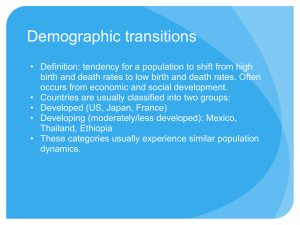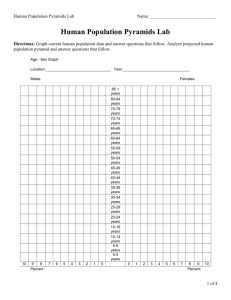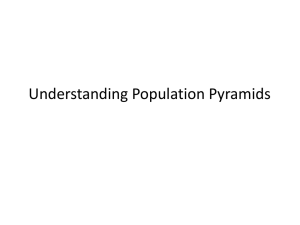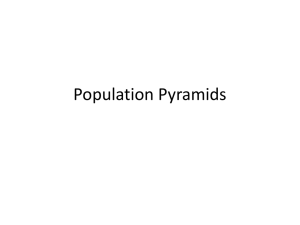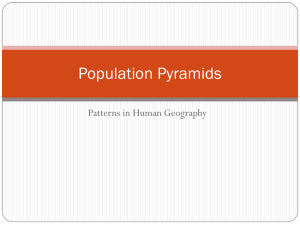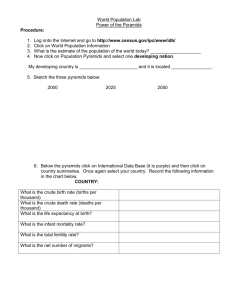“Shoshika”
advertisement
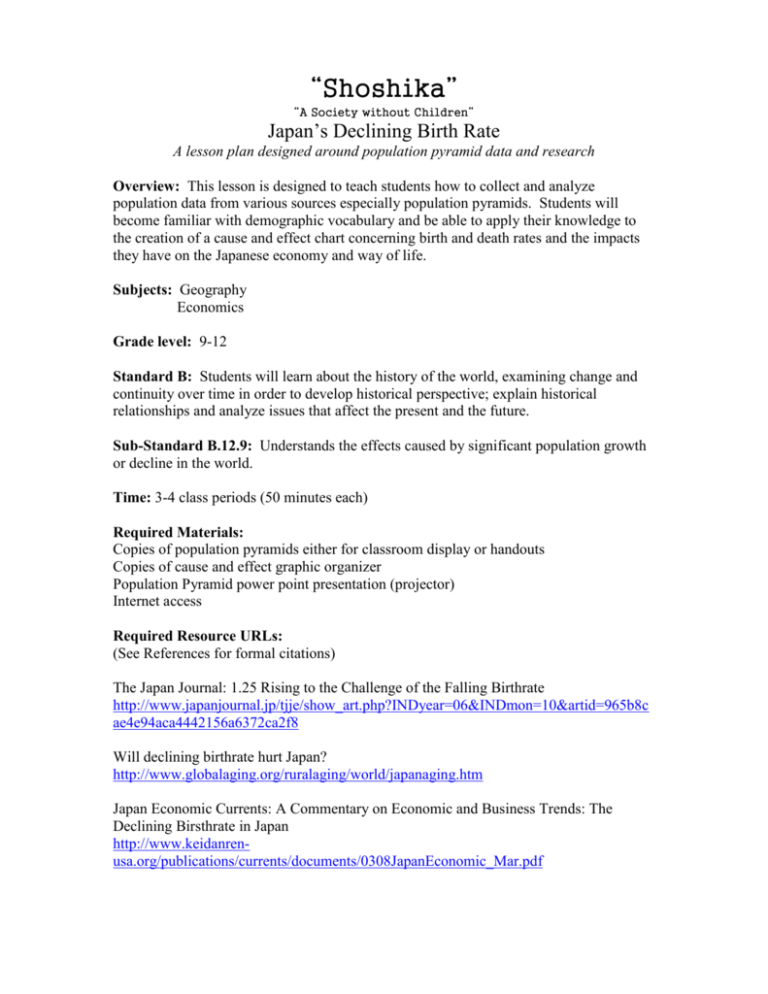
“Shoshika” “A Society without Children” Japan’s Declining Birth Rate A lesson plan designed around population pyramid data and research Overview: This lesson is designed to teach students how to collect and analyze population data from various sources especially population pyramids. Students will become familiar with demographic vocabulary and be able to apply their knowledge to the creation of a cause and effect chart concerning birth and death rates and the impacts they have on the Japanese economy and way of life. Subjects: Geography Economics Grade level: 9-12 Standard B: Students will learn about the history of the world, examining change and continuity over time in order to develop historical perspective; explain historical relationships and analyze issues that affect the present and the future. Sub-Standard B.12.9: Understands the effects caused by significant population growth or decline in the world. Time: 3-4 class periods (50 minutes each) Required Materials: Copies of population pyramids either for classroom display or handouts Copies of cause and effect graphic organizer Population Pyramid power point presentation (projector) Internet access Required Resource URLs: (See References for formal citations) The Japan Journal: 1.25 Rising to the Challenge of the Falling Birthrate http://www.japanjournal.jp/tjje/show_art.php?INDyear=06&INDmon=10&artid=965b8c ae4e94aca4442156a6372ca2f8 Will declining birthrate hurt Japan? http://www.globalaging.org/ruralaging/world/japanaging.htm Japan Economic Currents: A Commentary on Economic and Business Trends: The Declining Birsthrate in Japan http://www.keidanrenusa.org/publications/currents/documents/0308JapanEconomic_Mar.pdf Objectives: After completing these activities, students will be able to use population pyramids for analysis and comparison of data. Students will research and identify significant points from various publications. Students will categorize and explain the cause and effects of birth and death rates on a population. Students will suggest possible solutions to problems concerning declining (increasing) populations. Suggested Procedure: Day 1: Explain to students the role that demography plays in the world today. Demography is the study of population patterns and data which can be scientifically interpreted for use by government officials, economists, advertising agencies and others. The three main categories of collected data are: birth rates, mortality rates, and migration. Using the existing power point presentation on population pyramids, (or one you have created yourself), step students through the analysis of various pyramids representing countries around the world today. Suggested discussion questions: What can you learn about the population of this country by viewing the pyramid? 1. What data is represented on the population pyramid? 2. What does the pyramid tell us about life expectancies? 3. Which gender is expected to outlive the other? 4. Which bar represents the age group in this classroom? 5. Are there more people in the age group above or below yours? 6. Does this population consist of more elderly or young people? 7. Why would a country’s leader be interested in this data? 8. What kind of services will this country need to provide? 9. Why would an economist be interested in this data? 10. What kind of public policy needs does this county have? 11. What predictions can you make about future population patterns? Growth or no growth? Conclude by saying: “Tomorrow you will analyze the population pyramid representing the country of Japan and dig deeper into some of the issues facing this country’s future.” Day 2: computer lab Distribute or display Japan’s population pyramid which can be found on the following U.S. Census Bureau - International Data Base website (use tab labeled Population Pyramids). http://www.census.gov/ipc/www/idb/informationGateway.php Using the discussion questions from day 1, have students either independently or with a partner analyze Japan’s population data. If in a computer lab, allow students to explore several different years to see how the patterns of growth or decline have changed. (Preselect the years if desired). Encourage students to discuss possible reasons why these patterns exist; i.e.: war, baby boom periods, migration etc… Have students brainstorm ideas as to why population growth might slow or decline. Conclude by saying: “Tomorrow you will research and record the causes of Japan’s population decline and develop a list of the specific effects of the trend.” Day 3: computer lab Handout cause and effect chart. Students should examine the following publications and record their findings in the proper columns of the chart. Depending on the skill level of the students, you may want to assign the readings to specific students. Conclude by saying: “Tomorrow be prepared to share your findings with the class.” Day 4: Conduct a class discussion on the findings of the students recorded on their cause and effect charts. Create a master list on the board. In small groups have students suggest possible solutions to the problems Japan is facing due to population decline. Share with students measures that are currently being implemented in Japan and discuss their possible successes. Extension: Have students create their own logos for use by companies that support employees who have young families. See example currently in use at the following website: http://www.mhlw.go.jp/houdou/2007/02/h0216-3b.html Repeat the activity with a country that has the opposite trend in population growth, which would be high birth rates or an influx of immigrants. Design a logo to promote a slowing of population growth. Credits: Joan Brylski Pulaski High School Pulaski, Wisconsin 54162 jmbrylski@pulaski.k12.wi.us References Oshio, T. (n.d.). Japan Economic Currents: A Commentary on Economic and Business Trends: The Declining Birth rate in Japan . Retrieved October 28, 2009, from www.keidanrenusa.org/publications/currents/documents/0308JapanEconomic_Mar.pdf Sakurai, Y. (n.d.). Will declining birthrate hurt Japan?. Retrieved October 29, 2009, from http://www.globalaging.org/ruralaging/world/japanaging.htm Sawaji, O. (n.d.). The Japan Journal - 1.25 Rising to the Challenge of the Falling Birthrate. Retrieved October 29, 2009, from http://www.japanjournal.jp/tjje/show_art.php?INDyear=06&INDmon=10&artid= 965b8cae4e94aca4442156a6372ca2f8
